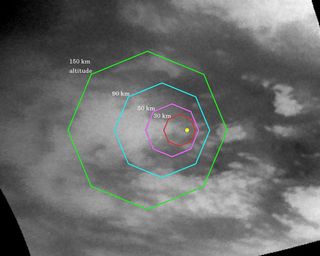Huygens Makes Good! ESA Probe Successfully Lands on Titan

DARMSTADT, Germany -- Europe's Huygens probe has successfully negotiated its descent to the surface of Saturn's mysterious moon, Titan, with its experiments switched on and continuing to collect data for two hours after its landing on what is probably a hard surface, Huygens program managers said.
U.S. and European officials had trouble holding back tears as they learned the news after long minutes of tense staring into computer screens at mission control center here.
"We have a scientific success,'' European Space Agency (ESA) Director-General said in a press briefing. "We will now be able to start breaking Titan's secrets."
ESA science team members said Huygens landed on Titan between 1345-1346 local time here (CET), which was about 7:45-7:46 a.m. EST. It took signals just over an hour to traverse the vast distances between Titan and Earth.
Originally expected to send perhaps 2.5 hours worth of data to the NASA's Cassini orbiter for later delivery to Earth, Huygens was still sending signals five hours after activation, and researchers said the probe's robust battery could last up to seven hours total.
Huygens has also been sending limited data directly to Earth, where it has been picked up by a network of telescopes. The detailed data about what it found on its way through Titan's thick atmosphere has been sent to NASA's Cassini orbiter overhead.
Get the Space.com Newsletter
Breaking space news, the latest updates on rocket launches, skywatching events and more!
Mission managers have reported only one single glitch in Huygens' data return. A redundant transmission channel is apparently not working properly, but only one of the probe's six instruments - a Doppler tool to study Titan's winds - is dependent solely on that channel and may be compensated for by data from ground-based observations, mission scientists said.
NASA's Cassini orbiter has also sent an initial data set of its own to ground teams. It will be several hours more before scientists decipher this information. But the mission has already cleared several of its biggest hurdles and has demonstrated enough to be declared a major event in the history of space science.
"This is a historic event," ESA Science Director David Southwood said. "The torch has now been passed from the engineers who delivered the probe and got the data sent to Cassini to the scientists who will evaluate the data."
Choking back tears, NASA Associated Administrator Al Diaz, who worked on the Cassini-Huygens mission for years before taking up his current post, said "It's up to ESA to take this data and turn it into science."
Diaz and Dordain embraced after they learned that Huygens' initial data was received by Cassini and ground telescopes confirming the initial success of the mission.
Officials said Cassini would continue to send its data packets in the coming hours. It is this data that will disclose details of what Huygens saw on its two-hour descent.
SPACE.com Staff Writer Tariq Malik contributed to this report from New York City.
Touchdown on Titan: Huygens Probe Hits its Mark
SPACE.com Special Report: Cassini-Huygens at Saturn and Titan
Join our Space Forums to keep talking space on the latest missions, night sky and more! And if you have a news tip, correction or comment, let us know at: community@space.com.

Charles Q. Choi is a contributing writer for Space.com and Live Science. He covers all things human origins and astronomy as well as physics, animals and general science topics. Charles has a Master of Arts degree from the University of Missouri-Columbia, School of Journalism and a Bachelor of Arts degree from the University of South Florida. Charles has visited every continent on Earth, drinking rancid yak butter tea in Lhasa, snorkeling with sea lions in the Galapagos and even climbing an iceberg in Antarctica. Visit him at http://www.sciwriter.us
